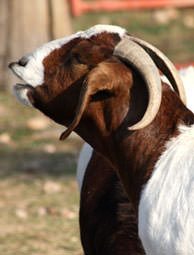
|
Last week, I talked a bit about goat behavior. Here is something else you may not know. In the picture my friend Kes is doing something odd you might see your goats, equines, cattle, llamas or alpacas, sheep, dogs or cats do. Wild things, like lions, tigers, deer, moose, tapirs and giraffes, do it, too. Kes isn’t laughing—she’s flehmening. (It’s from a German word meaning “to curl the upper lip.”)
Us studly bucks flehmen a lot, especially during rut, but does and wethers sometimes flehmen, too. Some goats flehmen more than others, though most goats flehmen when exposed to new, sharp scents. By curling their upper lips many kinds of mammals expose the vomeronasal organ (also called the Jacobson’s organ) in the roofs of their mouths and draws scent toward it. This behavior helps them identify what they smell, especially the scent of animals they don’t know and sexy scents, like females in heat. If your farm animal flehmens a lot when he usually doesn’t, check him out; flehmening can also indicate mild abdominal pain.
Another thing I didn’t mention last week is goats’ teeth. Did you know we don’t have teeth in our front upper jaws? Instead, we have a tough platform of flesh, called a dental pad, with a toothless gap behind it. Sheep, cattle, llamas, alpacas and all other ruminants, like deer and elk, have them, too. This makes it easier for us to use our tongues to select and collect yummy grass or twigs to eat, whereas animal that have front teeth, like horses, choose what to eat with their lips. A cow, for instance, wraps her long, rough, tongue around a wad of grass, pulls it into her mouth and fits the wad into the big gap between her front pad and back teeth. Then she pinches the strands about 6 inches from the ground between her bottom front teeth and her top dental pad, and, by swinging her head, neatly cuts herself a mouthful of grass.
Sometimes people ask my mom, “Do goats bite?” The answer is we usually don’t, but we surely can. Ask our sheep friend, Nick. Big Mama bit a mouth-size piece out of his ear! (That’s why his name is Nick)
It’s easy to estimate us goats’ age by examining the eight teeth in the front of our mouths. Baby goats are born with teeth. If all the teeth are sharp and small they are baby teeth and the goat is younger than 1 year old. If the center two teeth are big permanent teeth and the rest are small, the goat is between one and two years old. If the four center teeth are big and the rest are small, he is about 2 years old. If the six center teeth are big and the rest are small, he is about 2½ years old. If all eight teeth are big, he is about 3 years old. After that, our teeth gradually spread and eventually fall out in old age. But we can still eat grass and browse!




